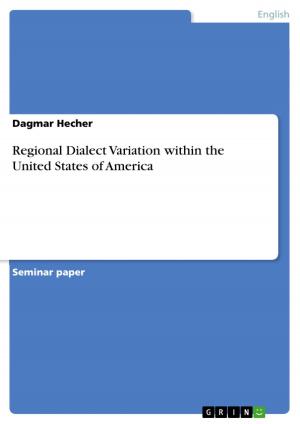A linguistic analysis of the word forming element 'pseudo-'
Nonfiction, Entertainment, Drama, Anthologies| Author: | Sandra Thillmann | ISBN: | 9783638034555 |
| Publisher: | GRIN Publishing | Publication: | April 10, 2008 |
| Imprint: | GRIN Publishing | Language: | English |
| Author: | Sandra Thillmann |
| ISBN: | 9783638034555 |
| Publisher: | GRIN Publishing |
| Publication: | April 10, 2008 |
| Imprint: | GRIN Publishing |
| Language: | English |
Seminar paper from the year 2007 in the subject English Language and Literature Studies - Linguistics, grade: 2,3, University of Marburg (Institut für Anglistik und Amerikanistik), course: Morphology and Syntax, 11 entries in the bibliography, language: English, abstract: In this term-paper I will examine the German word-forming element pseudo-/Pseudo- in order to find out about its meaning and function, its properties but also about its transparency and productivity. First of all I describe the procedure of collecting data and go into some essential basics. I will handle this in chapter two: Methodology. In chapter three I highlight meaning and origin of the element with information from dictionaries. Chapter four is about the dif-ferent properties of pseudo-. The subparagraph 'morphological and syntactic proper-ties' deals with the classification of morphemes according to Kortmann but also with the lexical category of the base and with the finding of particular suffixes. The phono-logical properties offer an analysis concerning syllables, stress pattern and pronuncia-tion whereas the semantic properties is about pseudo- as an pejorative prefix. Chapter five is called 'morphological status' and here I make a discussion about combining forms. In chapter six 'transparency', I define this term and describe how transparent the element is. The chapter of frequency and productivity (Chapter 7) is about how of-ten the element occurs and from this it follows a debate about its productivity rate. In the last chapter I compare pseudo- with möchtegern- and analyze it concerning a certain rivalry between the two morphemes. The analysis of the element pseudo- is based on the data collection of several corpora. I used the online dictionary and linguistic data base DWDS (Das Digitale Wörterbuch der deutschen Sprache des 20. Jh.). One of the eight corpora that the DWDS provides is called Corpus Berliner Zeitung. This corpus contains all online articles that have been appeared in the Berliner Zeitung from 3.1.1994 to 31.12.2005. It's scale is about 252 million tokens in 869.000 articles. I searched for pseudo* and I got 9 pages full of different pseudo-combinations. I tried to sort out the words that were not useful regarding to my analysis. Therefore I elimi-nated proper nouns or word formations that are well-established. For example pseudois-idorische Dekretalen (kirchenrechtliche Fälschungen) or pseudocýperus (Pflanzen-name). I put the words that can be found in a dictionary in brackets and therefore I did not include them in my analysis because dictionary words are not useable concerning an analysis of neologism.
Seminar paper from the year 2007 in the subject English Language and Literature Studies - Linguistics, grade: 2,3, University of Marburg (Institut für Anglistik und Amerikanistik), course: Morphology and Syntax, 11 entries in the bibliography, language: English, abstract: In this term-paper I will examine the German word-forming element pseudo-/Pseudo- in order to find out about its meaning and function, its properties but also about its transparency and productivity. First of all I describe the procedure of collecting data and go into some essential basics. I will handle this in chapter two: Methodology. In chapter three I highlight meaning and origin of the element with information from dictionaries. Chapter four is about the dif-ferent properties of pseudo-. The subparagraph 'morphological and syntactic proper-ties' deals with the classification of morphemes according to Kortmann but also with the lexical category of the base and with the finding of particular suffixes. The phono-logical properties offer an analysis concerning syllables, stress pattern and pronuncia-tion whereas the semantic properties is about pseudo- as an pejorative prefix. Chapter five is called 'morphological status' and here I make a discussion about combining forms. In chapter six 'transparency', I define this term and describe how transparent the element is. The chapter of frequency and productivity (Chapter 7) is about how of-ten the element occurs and from this it follows a debate about its productivity rate. In the last chapter I compare pseudo- with möchtegern- and analyze it concerning a certain rivalry between the two morphemes. The analysis of the element pseudo- is based on the data collection of several corpora. I used the online dictionary and linguistic data base DWDS (Das Digitale Wörterbuch der deutschen Sprache des 20. Jh.). One of the eight corpora that the DWDS provides is called Corpus Berliner Zeitung. This corpus contains all online articles that have been appeared in the Berliner Zeitung from 3.1.1994 to 31.12.2005. It's scale is about 252 million tokens in 869.000 articles. I searched for pseudo* and I got 9 pages full of different pseudo-combinations. I tried to sort out the words that were not useful regarding to my analysis. Therefore I elimi-nated proper nouns or word formations that are well-established. For example pseudois-idorische Dekretalen (kirchenrechtliche Fälschungen) or pseudocýperus (Pflanzen-name). I put the words that can be found in a dictionary in brackets and therefore I did not include them in my analysis because dictionary words are not useable concerning an analysis of neologism.















